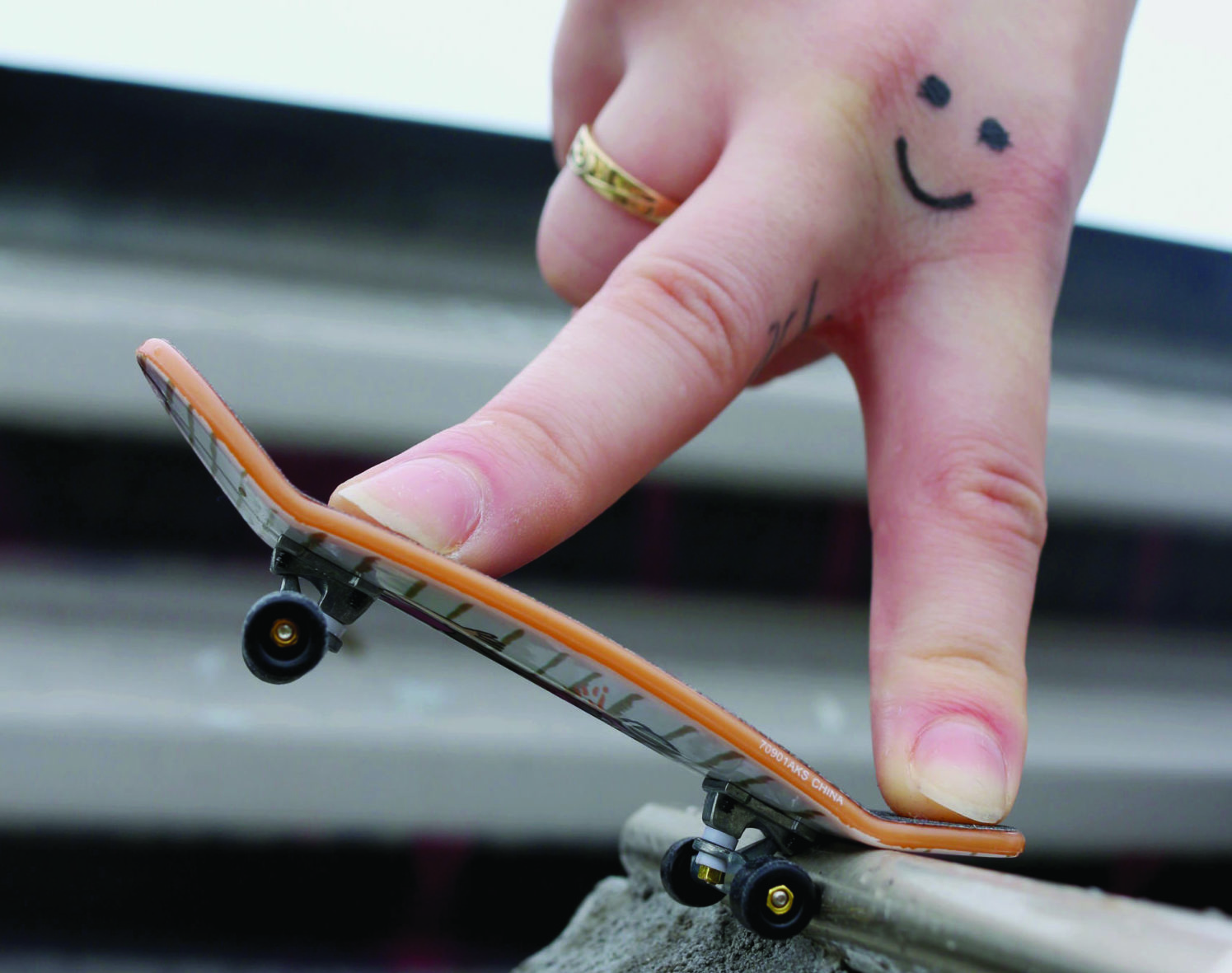
The recent construction of a miniature skate park in the heart of Atlanta’s skate culture is more than just the resurgence of Tech Decks.
While the park’s creator did not want to disclose park details or location to the public, the park’s tiny, scale-size quarter pipes remind those who cross its path that miniature skateboards have a history beyond a middle school classroom.
“It just started as like a novelty desk trinket and like anything it evolved into a hobby when people started realizing the potential of them,” Jason, the owner of successful hand and fingerboard company Hand Bros, who chooses to be referred to by only his first name, said.
The activity itself is self-explanatory: Use your fingers to maneuver a small skateboard. But many pros like famous fingerboarder Joe D say this seemingly easy fingerboarding requires the same precision and determination as skateboarding.
“When you work so hard to land any flip trick, it’s just as tough and rewarding as skating. You have to work for what you want, and you determine your progress,” Joe D said.
Emergence of Tech Decks
Initially designed as key-chains, miniature skateboards were never meant to hold the level of practicality that they do now. The late ‘90s saw an emergence of miniature skateboards from toy company Tech Deck, and the company even went as far as to include professional skater’s actual pro models’ boards on their product.
Tech Decks were fascinating. They worked in any environment and appealed to the demographic that Tony Hawk’s Pro Skater video game helped create. Twenty years later, skaters and the occasional kid who swears he should have lived in the ‘90s still carry the torch that Tech Deck lit.
“When I started fingerboarding back in the golden age of Tech Decks being popular, around 2002, it was a cool toy to have as a kid. I think everyone at school had at least one kind of Tech Deck,” famous fingerboarder Kenny Ende said.
It’s more than a toy
It’s easy to associate fingerboarding with children’s toys because of their resemblance to Tech Decks, but some fingerboarders are quick to establish a distinction between the two.
“Finger boards are not toys, they are professional things made of wood, big trucks and professional wheels,” Instagram Finger Boarder Spooky_FB said.
Other famous fingerboarders take on a more casual perception of their hobby.
“I try not to take myself, or my fingerskateboarding, too seriously, and always keep in mind how silly all of it can be. Even real-life skateboarding is just playing with a toy,” Ende said.
Fingerboards do command prices upwards of $100 dollars as opposed to five bucks for a Tech Deck – substantially more than your average toy. But because of its high quality of standard, fingerboards are vastly different from Tech Deck’s line of miniature skateboards.
“Tech Deck is a very popular brand,” Joe D said. “As far as differences in Tech Decks and fingerboards, fingerboards are made like normal skateboards. They are made of wood just like normal skate decks and glued together. The wheels have actual bearings in them and are made of urethane which actual skate wheels are made of.”
Why not have the real thing?
While the quality of fingerboards remains comparable to actual skateboards, skateboarding’s danger element is missing from fingerboarding. Chipping a nail is certainly no competition to crushing bones, yet fingerboarding is treated similarly in terms of competition.
X-Games and Tech Deck have been holding national tournaments for fingerboarding, going as far as having Tony Hawk host the final event in 2011. The tournaments show progress in the fingerboard community but leave the activity susceptible to backlash from actual skaters who throw themselves off staircases for nothing more than a pat on the back and a video clip.
Fortunately, the fingerboard community is heavily skater dependent as most fingerboarders participate in skateboarding as well.
“I would say most if not all skateboarders I know have a finger board or handboard,” Jason said.
No single aspect of fingerboarding can be pinned down as to its acceptability in skate culture — a culture that is known for questioning mimics or “posers.” However, certain elements of the activity stand out.
“The reason that I was even interested in them was because I was a skateboarder and loved the idea of mini-skateboarding. I think that fingerboarding certainly mimics the physics of real skateboarding. Even today I often think of the tricks I do in the same way I would on a real skateboard in terms of how to pop, flick and direct the inertia of the board,” Ende said.
For others, especially those undergoing treatment for injury, fingerboards resemble the same joy as skateboards.
“I know of a few people who are actually [of disability] and fingerboard because they can no longer skate and fingerboarding brings the same joy to them and feeling as skating,” Joe D said. “So, in that sense, it really does have a lot of things skateboarding has as far as physics.”
If fingerboarding doesn’t fulfill the same niche emotional response as skateboarding, some users flock to handboards. Roughly the size of an eggplant, the board requires two hands and performs similar actions to a skateboard.
Some companies such as Hand Bros will even go as far as putting on pants and shoes while skating on ledges to mimic actual street skating.
Whether ingenious or insane, both fingerboarding and handboarding have evolved significantly over the last ten years, providing yet another way to pop an ollie and innovate.
